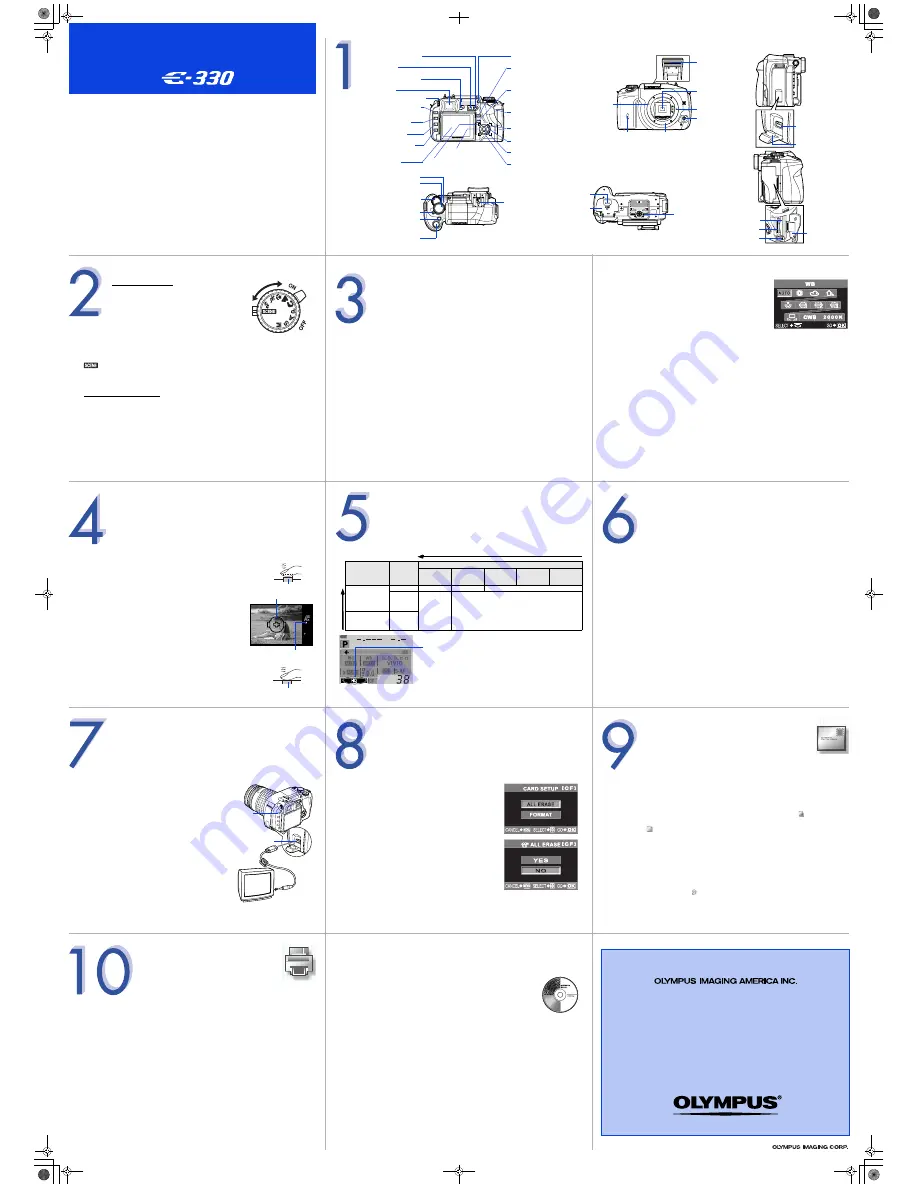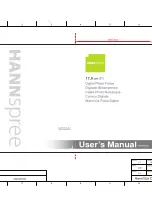
Quick Reference Guide
INDEX
1. Camera Diagram and Controls
2. How to use the mode dial
3. How to use the buttons and control dial
4. How to Use the Autofocus
5. Image Quality Modes
6. Flash Modes
7. Viewing Pictures on a TV
8. How to Erase All Pictures
9. E-mailing a Picture
10. Printing a Picture
CAMERA DIAGRAM AND CONTROLS
Hot shoe
Shutter button
Mode dial
F
(Exposure
compensation)
button
Power switch
Control dial
SSWF indicator
Self-timer/Remote
control lamp/
Remote control
receiver
Mirror
Lens release button
Lens attachment
mark
Mount
(Attach the lens after removing the
body cap from the camera to prevent
dust and dirt from entering the camera
body.)
Lens lock pin
Flash
Multi-connector
Connector cover
Battery compartment
lock
Battery compartment
cover
Tripod socket
Card cover
CF card slot
Eject button
xD-picture card slot
LCD monitor
Viewfinder
S
(Erase) button
INFO
(Information
display) button
MENU
button
q
(Playback) button
WB
(White balance) button
AEL
/
AFL
button
0
(Protect) button
j
(Drive) button
<
(Copy/Print) button
d
(Metering) button
i
button
ISO
button
Arrow pad
AF
(Focus mode) button
u
(Live view) button
#
UP
button
Eyepiece shutter lever
Diopter adjustment dial
A/B
button
Card access lamp
HOW TO USE THE MODE DIAL
Easy shooting modes
i
PORTRAIT
Suitable for shooting a portrait-style image of a person.
l
LANDSCAPE
Suitable for shooting landscapes and other outdoor
scenes.
&
MACRO
Suitable for taking close-up pictures (macro shooting).
j
SPORT
Suitable for capturing fast-moving action without blurring.
/
NIGHT & PORTRAIT
Suitable for shooting both the main subject and background at night.
20 different shooting modes are available to suit a wide range of shooting situations. When the mode
dial is set to this mode, the shooting mode selection screen is displayed.
Advanced shooting modes
P
Program shooting
Allows you to shoot using an aperture and shutter speed that the camera sets.
A
Aperture priority shooting
Allows you to set the aperture manually. The camera sets the shutter speed automatically.
S
Shutter priority shooting
Allows you to set the shutter speed manually. The camera sets the aperture automatically.
M
Manual shooting
Allows you to set the aperture and shutter speed manually.
HOW TO USE THE BUTTONS AND CONTROL
DIAL
This camera has a variety of functions to enable you to optimize settings
for various shooting conditions. You can set the functions using the
buttons and the control dial while viewing the monitor.
F
(Exposure compensation) button : Sets the exposure compensation value.
WB
(White balance) button :
Selects the white balance appropriate to the light source from the following
options: Auto, preset white balance settings, customized white balance
settings or registered white balance.
u
(Live view) button :
Sets the Live view mode. The subject is displayed on the LCD monitor. The
display for shooting information can be turned off by pressing the
INFO
button.
ISO
button : Sets the ISO sensitivity.
d
(Metering) button : Selects the metering mode.
AF (Focus mode) button : Selects the focus mode.
j
(Drive) button : Sets Drive / Remote / Self-timer.
a.
Press the button for the function you want to set
(direct button). The direct menu is displayed.
b.
Use the control dial
to set.
Other buttons
S
(Erase) button : Erases unwanted images.
INFO (Information display) button :
Shooting : Displays shooting information on the control panel screen.
Playback : Displays shooting information or histogram of the recorded image.
Each time this button is pressed, the information display is changed.
#
UP
(Flash) button : Raises the flash.
AEL
button : Locks the exposure.
q
(Playback) button : Plays back images on the monitor.
MENU button : Displays the menu.
0
(Protect) button : Protects images from being accidentally erased.
Manual flash : With [MANUAL FLASH] to set to [ON], you can set the amount of light
(FULL, 1/4, 1/16, or 1/64) in the flash mode setting.
HOW TO USE THE AUTOFOCUS
a.
While positioning the AF frame over the subject,
press and hold the shutter button halfway.
b.
The AF confirmation mark indicating that the focus
and exposure are locked remains lit as long as the
shutter button is kept depressed.
c.
Press the shutter button completely to take the
picture.
Shutter button
Halfway down
AF confirmation mark
AF frame
Shutter button
All the way down
IMAGE QUALITY MODES
Your camera is equipped with multiple image quality modes, which
determine the quality and image size of the pictures you take. Below is
a general description of the commonly used modes. For a detailed
description of all quality modes, refer to the Advanced Manual.
Application
Number of
pixels
Quality (Compression)
Uncompressed
1/1
Low
compression
1/2.7
High
compression
1/4
High
compression
1/8
High
compression
1/12
Select for the print
size
3136x2352
TIFF
SHQ
HQ
2560x1920
1600x1200
1280x960
1024x768
–
SQ
For small-sized
print and website
640x480
Image becomes clearer
Numb
er
of pixels incr
eases
You can set the image quality from the control
panel screen displayed on the LCD monitor. Press
the
i
button and use the arrow pad to move the
cursor to the image quality mode. Then turn the
control dial to select the setting.
Control panel screen
FLASH MODES
This camera features multiple flash modes. You can select the
appropriate flash mode to the suit the situation.
You can set the flash mode from the control panel screen displayed on
the LCD monitor. Press the
i
button and use the arrow pad to move
the cursor to [FLASH MODE]. Then turn the control dial to select the
setting.
AUTO
• Auto-flash - The camera decides if the flash is needed.
!
• Red-eye reduction flash - Reduces the incidence of red-eye by
emitting pre-flashes to shrink pupil size before taking the picture.
!
SLOW
• Slow synchroni Red-eye reduction flash - This mode is for
SLOW when you want to use slow synchronization, yet also
reduce the red-eye phenomenon.
#
SLOW
• Slow synchronization (1st curtain) - The flash fires right after the
shutter fully opens.
#
SLOW2
• Slow synchronization (2nd curtain) - 2nd curtain flash fires just
before the shutter closes.
#
• Fill-in flash - The flash always fires. Suitable for taking subjects lit
from behind by strong light.
$
• Flash off - The flash is turned off. Suitable for when flash
photography is not permitted. In this mode, the flash can be used
as an AF illuminator when it is raised.
VIEWING PICTURES ON A TV
a.
Turn the camera and TV off, and connect the
video cable as illustrated.
b.
Turn on the TV and set it to the video input
mode. For details on switching to the video
input mode, refer to the TV’s instruction
manual.
c.
Turn the camera on and press the
q
(playback) button.
Note: If the pictures are not displayed, consult
your TV manual to set up the video
source.
q
button
Video cable
Multi-connector
Video input
terminal
HOW TO ERASE ALL PICTURES
WARNING - PERFORMING THESE STEPS WILL DELETE ALL STORED
PICTURES!
a.
Press the
MENU
button. Use
ac
to select
[
W
]
, then press
d
.
b.
Use
ac
to select [CARD SETUP], then press
d
.
c.
Use
ac
to select [ALL ERASE], then press
the
i
button.
d.
Use
ac
to select [YES], then press the
i
button.
E-MAILING A PICTURE
Using the OLYMPUS Master software (included), you can share your pictures with
others by using the built-in e-mail feature.
After installing OLYMPUS Master, open the program and click “ Browse
Images”. From the “Browse” window, select the picture(s) you want to send and
click the “ E-mail” tool button.
At this time, you can resize your pictures to make them more manageable for e-
mail. This helps you stay within the e-mail capacity limitations set by your e-mail
provider.
When finished, click the “ Launch Mailer” button at the bottom of the
window. Your default e-mail program will open, and the selected picture(s) will
automatically be attached to a new message.
© 2006
PRINTING A PICTURE
Using the OLYMPUS Master software (included), you can make prints of your
pictures using your own photo printer.
After installing OLYMPUS Master, open the program and click the “Print Images”
icon on the main menu. You can create many different types of prints such as an
index print, photos, albums, or calendars. Simply select the image(s) and add
them to one of the many layouts within OLYMPUS Master. For detailed
instructions, please refer to the “Help” menu in the software.
You can also order prints online using the “Print Online” feature in OLYMPUS
Master.
Alternatively, you can print your pictures by connecting your PictBridge*
compatible camera directly to a PictBridge* compatible printer, such as the
Olympus P-10 Digital Photo Printer. This permits fast, easy printing without using
a computer.
*For detailed instructions on using PictBridge, please refer to your camera’s
Advanced Manual.
What you can do with OLYMPUS Master software
• The provided software CD includes OLYMPUS Master
software for viewing and editing images. Once
installed, you can take advantage of viewing and
editing your images as shown below. For information
on how to use OLYMPUS Master software, see Help
after installation.
• Install OLYMPUS Master on your computer from the provided CD-ROM.
OLYMPUS Master allows you to register as the camera’s owner. Doing so will
enable you to receive information on software or firmware upgrades from
Olympus.
CONTACT INFORMATION
Two Corporate Center Drive, P.O. Box 9058, Melville, NY 11747-9058
Technical Support (USA):
24/7 online automated help: http://www.olympusamerica.com/E1
Phone customer support: 1-800-260-1625 (toll free)
Our phone customer support is available from 8am - 10pm, (Monday to
Friday) ET
E-mail: [email protected]
Olympus software updates can be obtained at: http://olympus.com/digital
E330_QSG_EN.fm Page 2 Wednesday, December 28, 2005 11:53 AM




















